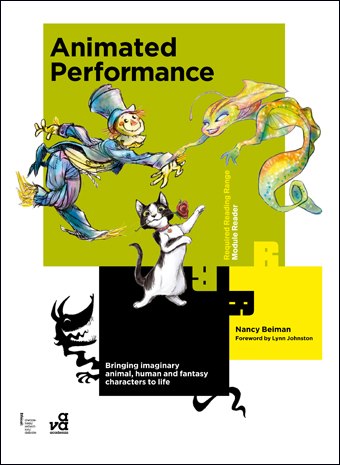Read how imagination-based exercises really shine in the latest book by Nancy Beiman.
The thing that sets Nancy Beiman's Animated Performance (AVA Books) apart from most other animation manuals is that it isn't geared toward beginners. It's one of the few animation books that does not start off with a bouncing ball. It's a book that assumes you've already read your Preston Blair. It mixes a series of examples, quotes and interviews with step-by-step exercises.
I found the book helpful and informative when Nancy drew lessons from her extensive animation experience. These included examples from her work at Disney, along with quotes from her interviews with Art Babbitt, Mae Questrel and others. It's nice to see generic characters demonstrating certain techniques, but it's always special to see a scene I can remember, broken down and explained in an artistic and logical way.
At first, the organization of the book really confused me. I've become accustomed to animation books that start with basic principles and progress into more complicated applications of those principles. This book is organized by general themes, but without a linear progression of complexity from one section to the next. For instance, the chapter on "Animal actors" starts with quadrupeds, then winged characters, then characters with four legs and wings and finally worms. I would have preferred to start off with a worm, and then tackle a Pegasus. "You must crawl before you can walk," states the quote that introduces the section about worms.
The theme of the chapters can also get a bit perplexing --the first chapter covers storyboards and thumbnails, and the last two cover staging and story arcs. These chapters would have made more sense if grouped together. The "Is sex necessary?" chapter logically covers techniques for animating characters of different sexes, but for some reason spends its second half covering movement traits for differently aged characters. These are related, of course, but why give a chapter a name that only relates to half its contents?
I suppose the arrangement of this book was more difficult than most, since it isn't starting off with the bare-bones basics, but I really wish the chapters were arranged so that each built more directly off the preceding chapters. This is especially confusing since the exercises included in the book are arranged very well, with each building off the last in a clear and helpful way.
All this griping isn't meant to put-down the actual information covered in the book. There are some fantastic ideas in here. Though it might be difficult for some animators to follow, an experienced animator will be able to find many ways to improve their skills.
Nancy approaches animation from a very imagination-based method. Her dislike of live-action reference and "acting it out" is made very clear -- at times reminding me of Richard Williams' anti-bottom-pegging stance. Her imagination-based exercises are where this book really shines. They're great. Every five or 10 pages, Nancy adds a clear, concise, well-planned and thoughtful exercise that directly relates to the preceding text. They are the kind of exercises that appear to have been developed by an excellent teacher after years of hands-on knowledge in the classroom. I'd love to try them all.
Again, though the layout and organization of the book can be confusing at first, Animated Performance i s worth a look. If you're looking for great tips and exercises to polish your character animation skills, give it a try.
Fran Krause studied at the Rhode Island School of Design, made a couple pilots for Cartoon Network and a handful of independent animations. He currently is an instructor in the Character Animation department at CalArts.








